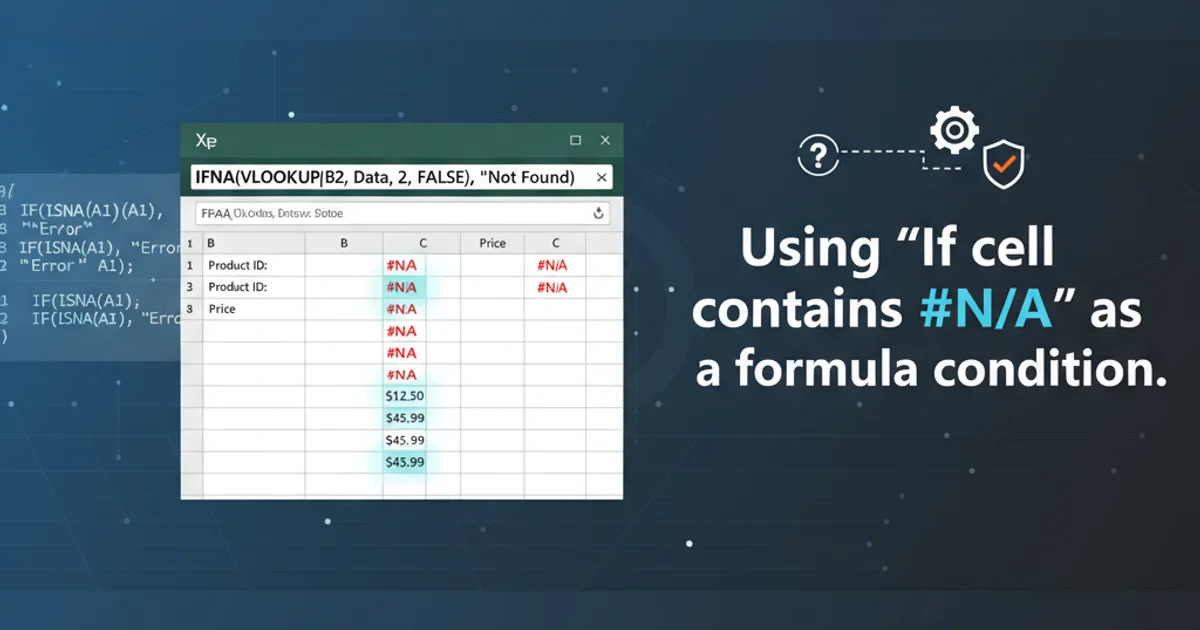Using "If cell contains #N/A" as a formula condition.
Categories:
Mastering Excel: Conditional Logic with '#N/A' Errors

Learn how to effectively use Excel formulas to check for and handle '#N/A' errors, enabling robust and error-proof spreadsheets.
Excel's #N/A error is a common sight, indicating that a value is 'not available' or 'no match found'. While often a sign of an issue, it can also be an expected outcome in certain lookups or data manipulations. This article will guide you through various methods to detect and conditionally react to #N/A errors within your Excel formulas, making your spreadsheets more resilient and user-friendly.
Understanding the '#N/A' Error
The #N/A error typically arises from functions like VLOOKUP, HLOOKUP, MATCH, or LOOKUP when they cannot find a specified value. It's crucial to distinguish #N/A from other Excel errors like #DIV/0!, #VALUE!, or #REF!, as each signifies a different underlying problem. For conditional logic, we often want to specifically target #N/A to provide alternative results or messages, rather than letting the error propagate.
flowchart TD
A[Start Formula Evaluation] --> B{Is the result an error?}
B -- No --> C[Return calculated value]
B -- Yes --> D{Is the error specifically '#N/A'?}
D -- Yes --> E[Apply '#N/A' specific handling]
D -- No --> F[Apply general error handling or return error]
E --> G[End]
F --> G[End]Decision flow for handling errors in Excel formulas
Using IFNA for Simple '#N/A' Handling
The IFNA function (available in Excel 2013 and later) is the most straightforward way to handle #N/A errors. It checks if a formula evaluates to #N/A and, if so, returns a specified value; otherwise, it returns the result of the formula. This is ideal when you only care about #N/A and want to ignore other error types.
=IFNA(VLOOKUP(A2, B:C, 2, FALSE), "Not Found")
Example of IFNA replacing #N/A with 'Not Found'.
IFNA is concise, remember it only catches #N/A. If you need to handle other error types (like #DIV/0!), you'll need the more general IFERROR function or a combination of IF with ISNA or ISERROR.Advanced Handling with IF and ISNA
For older Excel versions or when you need more granular control, combining IF with ISNA is the classic approach. ISNA returns TRUE if a cell contains #N/A and FALSE otherwise. This allows you to build more complex conditional logic around the presence of #N/A.
=IF(ISNA(VLOOKUP(A2, B:C, 2, FALSE)), "Item not in list", VLOOKUP(A2, B:C, 2, FALSE))
Using IF and ISNA to provide a custom message for #N/A.
IF(ISNA(...), ..., ...) with a lookup function, you'll notice the lookup function is repeated. This can impact performance on very large datasets. For modern Excel, IFNA or XLOOKUP are generally more efficient.Leveraging XLOOKUP for Built-in Error Handling
Excel's XLOOKUP function (available in Microsoft 365 and Excel 2021) is a powerful successor to VLOOKUP and HLOOKUP. One of its key advantages is a built-in if_not_found argument, which directly addresses the need to handle cases where a lookup value isn't found, effectively replacing the need for IFNA or ISNA in many scenarios.
=XLOOKUP(A2, B:B, C:C, "Product ID not found")
Using XLOOKUP's if_not_found argument to handle missing values.
XLOOKUP function is highly recommended for its flexibility, efficiency, and built-in error handling. If you have access to it, prioritize XLOOKUP over VLOOKUP and HLOOKUP.